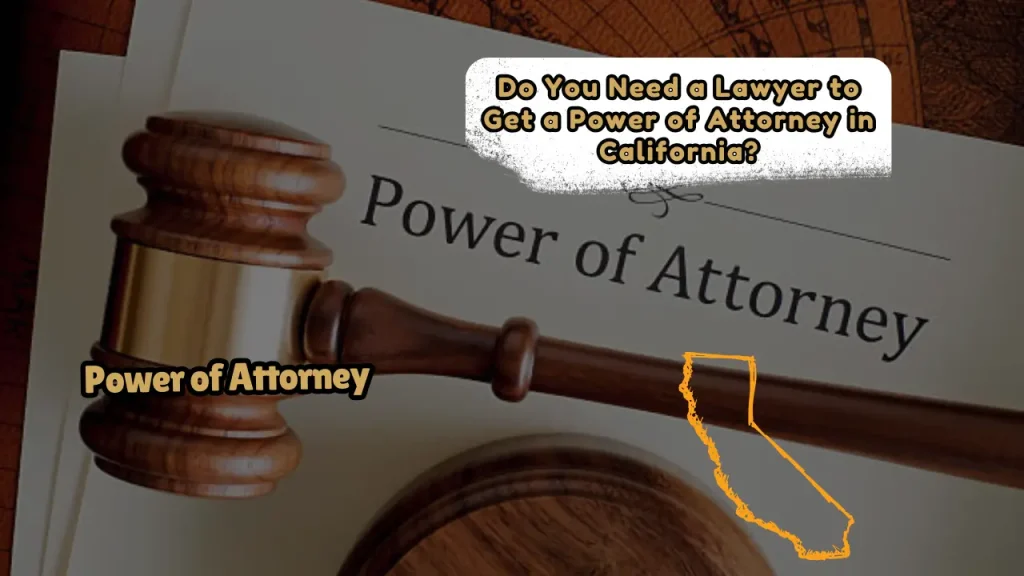Do You Need a Lawyer to Get a Power of Attorney in California?
No, you do not legally need a lawyer to create a Power of Attorney (POA) in California. You can use state-provided statutory forms or reputable online templates to draft your own POA. However, if your situation involves complex estates, family dynamics, or Medicaid planning, consulting an attorney is highly advisable to ensure your document meets all legal requirements and is tailored to your needs.
Table of Contents
Legal Requirements for a Valid POA in California
California law outlines strict formalities for a POA to be enforceable:
- Signing and Witnessing:
The principal must sign the document in the presence of two adult witnesses (unrelated to the principal or agent) and a notary public, especially for financial POAs involving real estate. - Durability Clause:
For a POA to remain valid if the principal becomes incapacitated (durable POA), it must explicitly state:
“This Power of Attorney shall not be affected by subsequent incapacity of the principal” (or similar language). - Agent Qualifications:
The agent must be at least 18 years old and mentally competent. You may also name co-agents or successor agents. - Statutory Forms:
Using statutory forms provided by the California Probate Code (e.g., the Uniform Statutory Form for financial POAs) simplifies the process and is widely accepted by institutions.
Failure to meet these requirements can render your POA invalid, leading to its rejection by banks or hospitals.
When You Don’t Need a Lawyer
For straightforward cases, a DIY approach is both feasible and cost-effective. Consider creating your own POA if:
- Simple Financial Tasks:
Managing bank accounts, paying bills, or handling routine transactions for a trusted spouse or family member. - Using Statutory Forms:
California’s pre-approved forms (e.g., Probate Code § 4401 for financial POAs) can be filled out without legal expertise. - Online Services:
Platforms like LegalZoom or Nolo’s WillMaker offer customizable, state-compliant templates typically costing between $10 and $100.
DIY Steps:
- Choose the Type:
Select a financial, medical, or limited POA based on your needs. - Complete the Form:
Use statutory templates or online tools. - Execute Properly:
Sign in the presence of two witnesses and a notary (mandatory for real estate transactions). - Distribute Copies:
Provide copies to your agent, banks, and relevant institutions.
Related articles for you:
Do You Need a Lawyer to Get a Power of Attorney in Texas?

When Hiring a Lawyer Is Advisable
Legal guidance is critical in complex scenarios to avoid pitfalls:
- High-Value or Complex Assets:
Managing businesses, multiple properties, or significant investments requires precise language to prevent misuse or tax issues. - Family Disputes or Co-Agents:
If there’s potential for conflicts among family members or co-agents, a lawyer can draft clauses to resolve disputes and clarify whether agents act jointly or independently. - Medicaid Planning:
Tailored POAs are essential for asset protection and eligibility; generic forms often lack the necessary detail. - Healthcare Directives:
Combining a medical POA with a living will (an advance healthcare directive) ensures compliance with California’s strict rules. - Springing POAs:
Although California largely eliminated new springing POAs post-2011, pre-existing ones require clear triggers (e.g., physician certification) to avoid disputes.
A lawyer can also resolve issues like bank rejections by ensuring compliance with California’s POA Act, which holds institutions liable for refusing valid documents.
Risks of a DIY POA
Mistakes in self-drafted POAs can lead to:
- Invalidation:
Missing notarization, witness signatures, or durability clauses may render the document unenforceable. - Rejection by Institutions:
Banks or hospitals might refuse a poorly drafted POA, delaying urgent transactions. - Overly Broad Authority:
Ambiguous language could grant unintended powers, increasing the risk of financial abuse. - Guardianship Proceedings:
If the POA fails, families might need to pursue court-appointed guardianship, which can be far more expensive.
Cost Comparison: Lawyer vs. DIY
| Option | Cost Estimate | Best For |
| DIY Templates | $0 – $50 | Simple POAs, trusted agents |
| Online Services | $50 – $200 | Customizable forms with basic legal review |
| Lawyer Drafted | $200 – $500+ | Complex estates, disputes, Medicaid planning |
Additional costs include notary fees (approximately $10–$25) and any extra witness services.
Steps to Create a Valid POA Without a Lawyer
- Download a Statutory Form:
Use California Probate Code templates for financial or healthcare POAs. - Define Powers Clearly:
Specify whether the agent can manage real estate, investments, or medical decisions. - Sign and Notarize:
Follow the witnessing rules (two unrelated adults) and have the document notarized. - Store Securely:
Keep the original document accessible to your agent and relevant institutions.
For those facing complex situations, you may also be interested in our guide How to Get Power of Attorney for Someone Who Is Incapacitated?, which explains the process and nuances of establishing a POA when the principal is unable to act on their own.
Conclusion
While you do not need a lawyer to create a Power of Attorney in California, professional assistance is invaluable for complex estates, family dynamics, or Medicaid planning. DIY options work well for straightforward cases, but they carry risks if statutory formalities aren’t met. By prioritizing clarity, compliance, and foresight, you can ensure your POA stands up when needed most.
Disclaimer: This article provides general information and does not constitute legal advice. Consult a qualified attorney for guidance tailored to your specific situation.
About the Author

Sarah Klein, JD, is an experienced estate planning attorney who has helped clients with wills, trusts, powers of attorney, and probate matters. At All About Lawyer, she simplifies complex estate laws so families can protect their assets, plan ahead, and avoid legal headaches during life’s most sensitive moments.
Read more about Sarah
